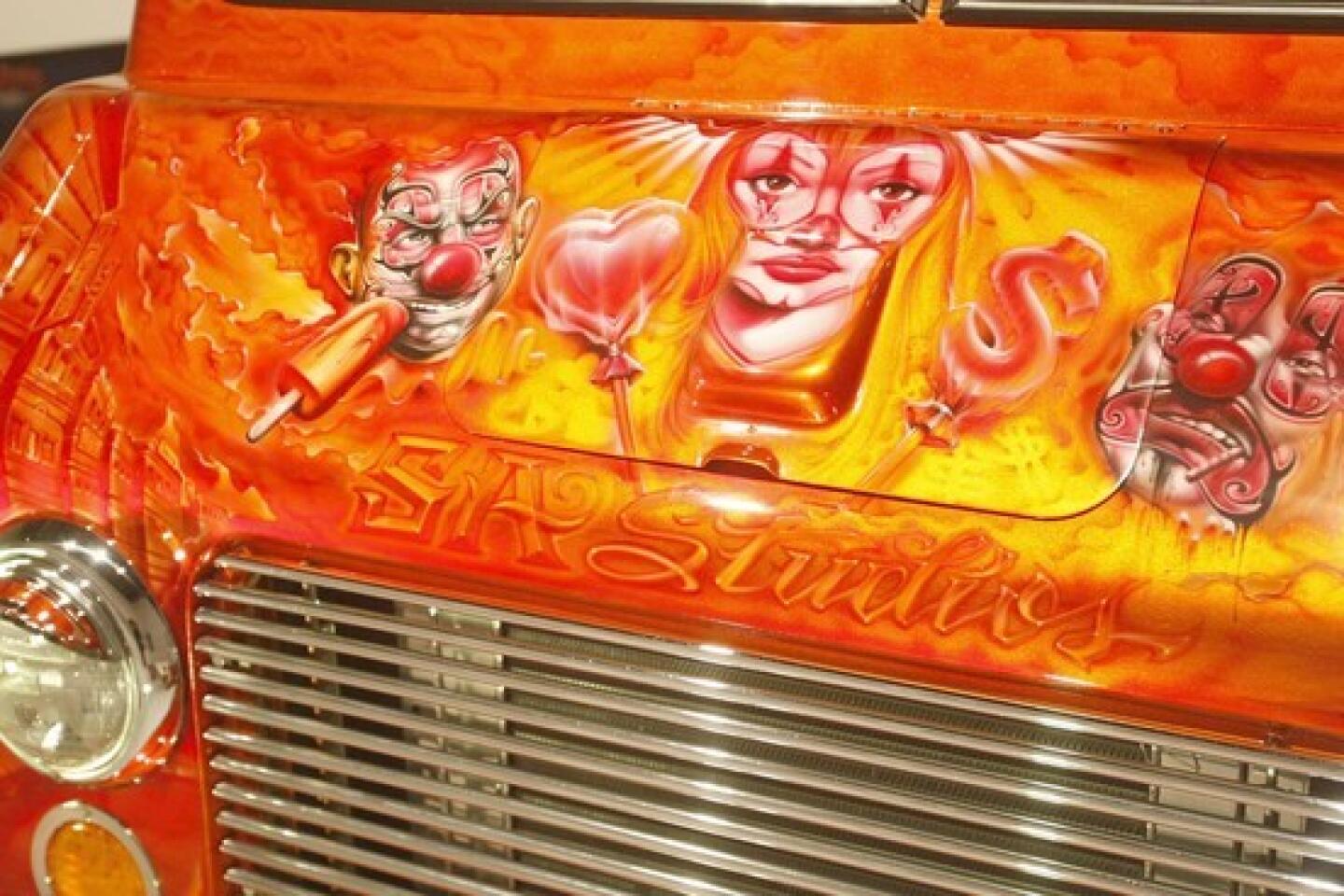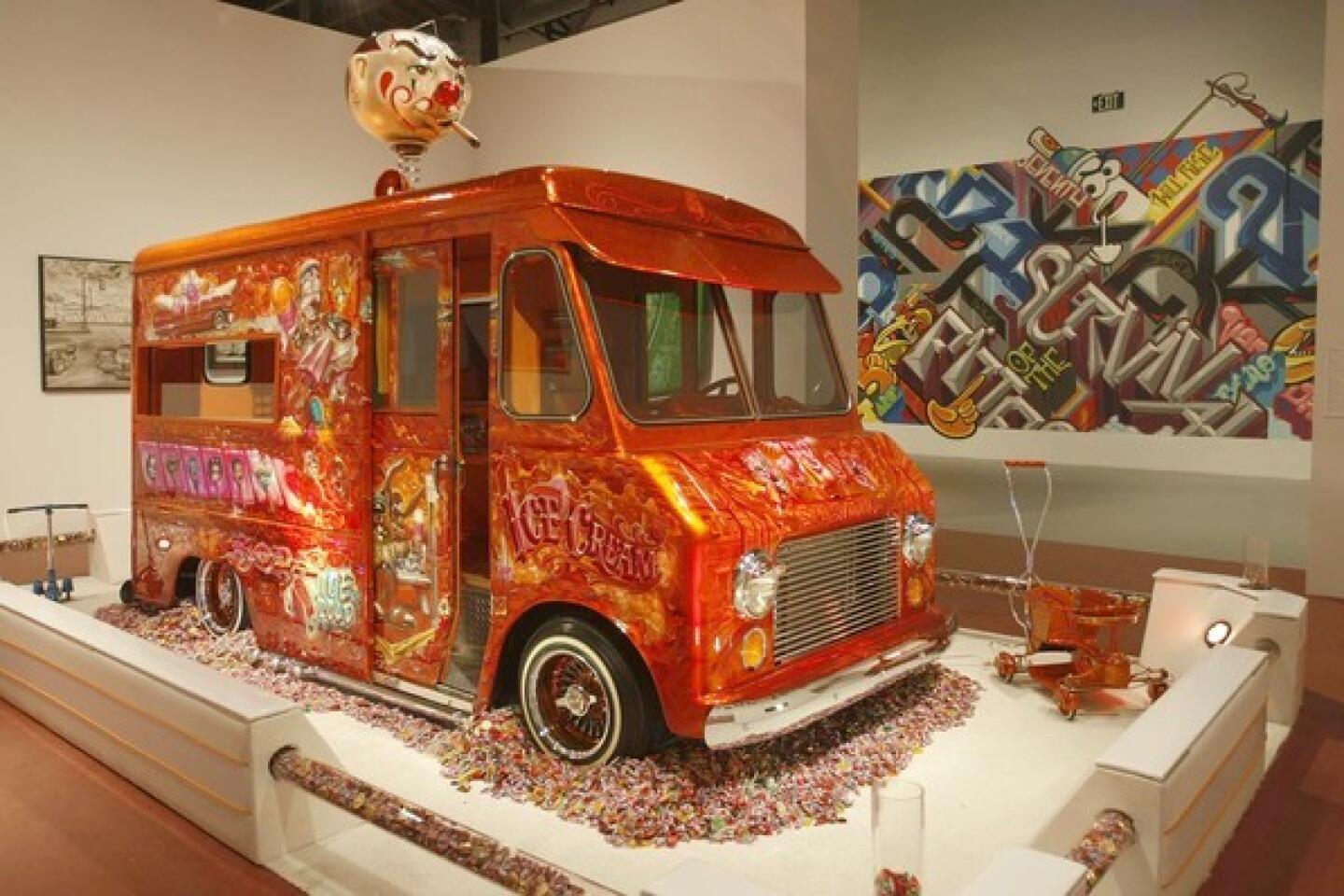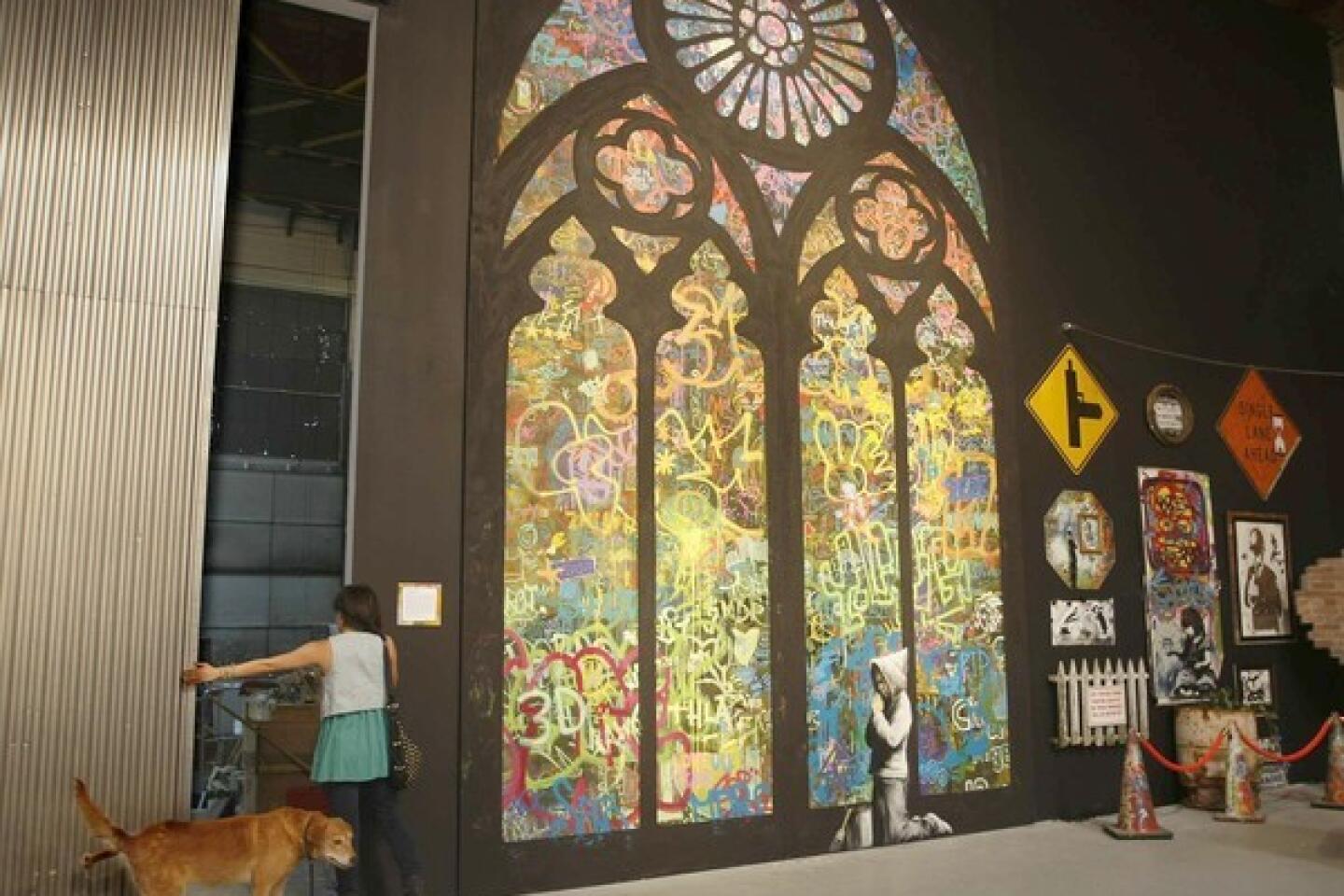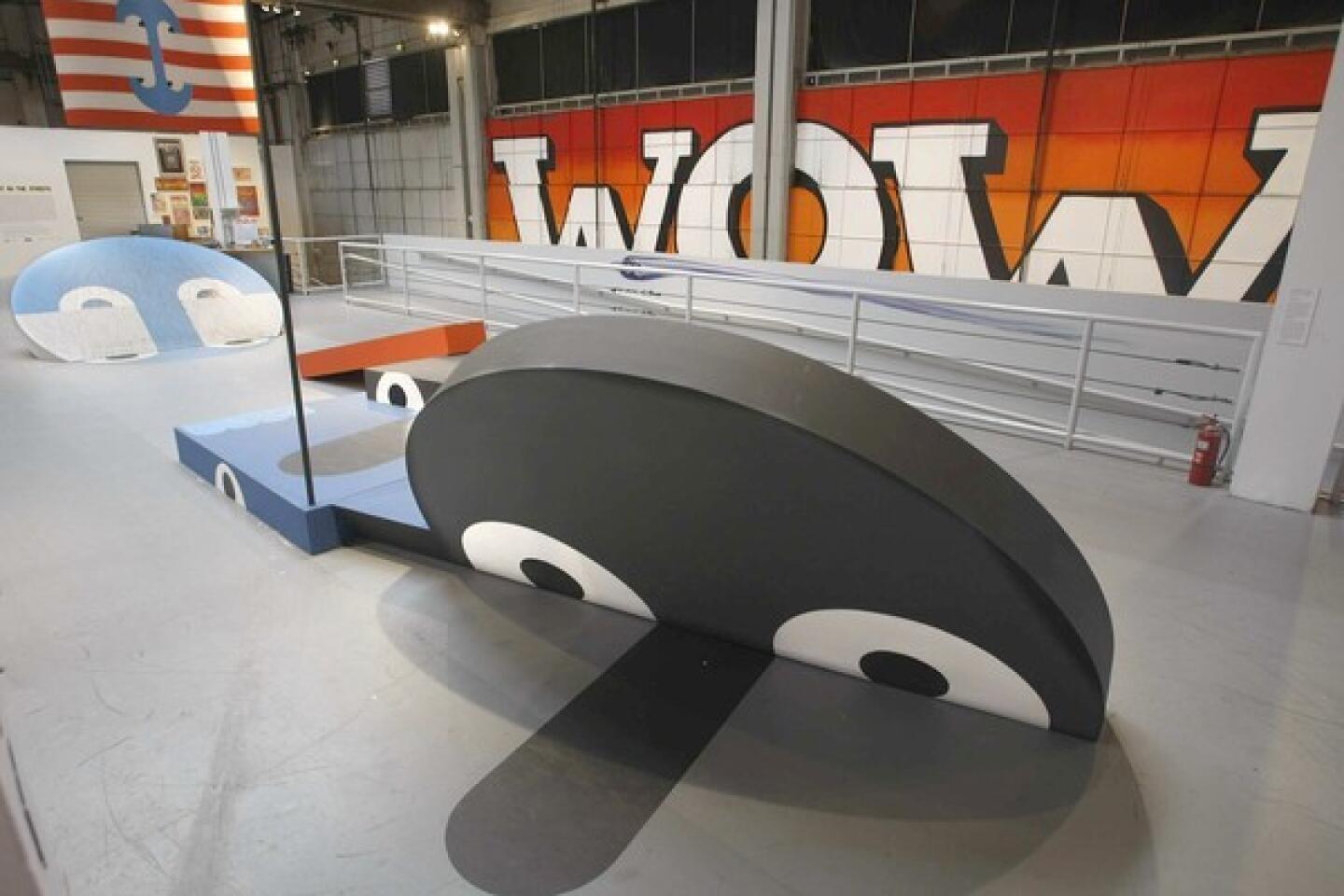Neglected Whittier mural by F. Carlton Ball gets noticed
- Share via
A large but little-noticed mural that a noted ceramic artist, F. Carlton Ball, created in an alcove of a public library branch in Whittier is having its moment in the spotlight after what may or may not have been a near-brush with the wrecking ball.
“Pictures of Children’s Stories” is 12 feet high and 8 feet wide and has stood in a short passageway between the circulation desk and the adult wing of the Whittwood Branch Library since the building opened in 1968.
It consists of more than 100 square and rectangular tiles of irregular size, in glazed-over shades of blue, green, copper and silver. There are 79 scenes from beloved books — Long John Silver from “Treasure Island” appears with his sword and treasure chest; Aladdin’s genie towers above his master; the Cheshire cat grins down upon Alice; Goliath staggers from David’s fatal slingshot. Near the ceiling, between tiles showing the winged horse Pegasus and two knights jousting, Rip Van Winkle awakens and rubs his eyes.
Ball, who died in Tacoma, Wash., in 1992 at age 81, according to an Associated Press obituary, made his mark mainly with pottery during a long career as an artist, art professor and author of books on ceramics-making. He trained at USC in the early 1930s and returned there as an art professor from 1956 to 1967; he taught at several other institutions, including Oakland’s Mills College, the University of Wisconsin and the University of Puget Sound.
“He was one of the great icons of ceramics in the middle 1900s,” said David Armstrong, founder and president of the American Museum of Ceramic Art in Pomona, where Ball’s pottery will be included in “Common Ground: Ceramics in Southern California, 1945-1975,” opening Nov. 12 as part of Pacific Standard Time, the Getty-initiated regionwide survey of postwar Los Angeles art.
Armstrong — and the Los Angeles Times — learned of the mural’s existence only this week, alerted by Roberto Chavez, a Whittier photographer. Since first encountering it Sept. 29, Chavez has committed himself to making sure it doesn’t become a casualty of the $5.3-million renovation and expansion of the Whittwood Branch, which will close Oct. 30 for construction expected to begin in December and take a year.
Chavez, 41, said he got involved when he was contacted by an assistant to Paymaneh Maghsoudi, the city’s director of library services. He is a member of Whittier’s Cultural Arts Commission, and last spring his photos of Parisian scenes were displayed at the city’s central library.
Chavez says he was told the mural was going to be destroyed and that the library wanted him to photograph it so there would be a record of it and perhaps a chance to do a photographic reconstruction and display in the future. Maghsoudi said, however, that Chavez is mistaken; interviewed Wednesday, she said his photographs were intended to help inform a process about what to do with the mural.
On his first visit to the mural, Chavez immediately was struck by its size and the quality of its glazing and pictorial renderings. “Ceramics is not my thing,” he said, but his instincts and his training at Pasadena’s Art Center College of Design told him this was a significant work. There’s a prominent white crater on one of the blue, nonpictorial tiles near the floor, and he said he learned that it came from a worker testing to see whether the tiles could be removed one by one.
Chavez went online and learned that Ball’s work is in museum collections — including one piece each at the Los Angeles County Museum of Art and New York’s Metropolitan Museum of Art, according to their online catalogs. He learned that Ball’s son, Fred Uhl Ball, followed in his father’s footsteps and was considered an important figure in his own right, creating large-scale enamel murals until 1985, when he died at 40 after being robbed and beaten outside his studio in Sacramento.
On Oct. 4, Chavez says, he photographed the mural; the next day, as he turned in his pictures at the central library, he says he had a brief conversation with Maghsoudi in which she mentioned that perhaps the ceramic tiles could be removed and displayed individually. Chavez did not feel reassured; he thinks the mural needs to remain intact.
After alerting Maghsoudi and Fran Shields, Whittier’s Parks, Recreation and Community Services director (who oversees the Cultural Arts Commission), that Ball appeared to be a significant artist, Chavez still felt the work was in jeopardy. He wondered why “Pictures of Children’s Stories” hadn’t been brought to the arts commission for its input, more than eight months after the City Council had awarded the project’s design contract to Glendale-based architects CWA AIA Inc.
On Wednesday, Maghsoudi and Rob Settlage, chairman of the Whittier Public Library’s board of trustees, said that officials never planned to let the mural be destroyed. The intent all along was to gather information about the cost and feasibility of preserving the mural, then let the City Council decide what to do, Maghsoudi said.
Settlage said that library officials contacted LACMA and the Huntington Library, Art Collections and Botanical Gardens this week in hopes of finding a qualified appraiser and checked with the project architects, who he said have “ideas that are new and in formation” about possibilities for preserving the mural. The library has funds for an appraisal, Settlage said, but it will be the City Council’s call whether Whittier should sink additional money into the mural.
If Whittier decides it can’t afford to save the mural, the American Museum of Ceramic Art would love to have it, said Armstrong, its president. He planned to visit “Pictures of Children’s Stories” this week, but the photograph Chavez sent already has convinced him that it’s a museum piece, especially given Ball’s stature and because he rarely did murals. Removing the tiles from the library’s drywall “is not going to be prohibitively expensive” for the museum, he said, although if the city were to demand additional payment for the mural itself, that would be a problem.
Told of Armstrong’s interest, Settlage said that a new home at the Pomona museum “would be a great option” if keeping the mural in Whittier proves unaffordable.
Chavez hopes it will stay put, perhaps in a different spot at the Whittwood Branch, with an improved presentation that will turn it from an afterthought into a showpiece. “To have such a piece of art in our community, we should all be very proud, and it’s important to preserve it,” he said.
More to Read
The biggest entertainment stories
Get our big stories about Hollywood, film, television, music, arts, culture and more right in your inbox as soon as they publish.
You may occasionally receive promotional content from the Los Angeles Times.

















